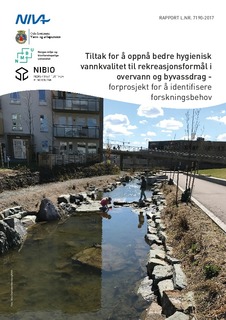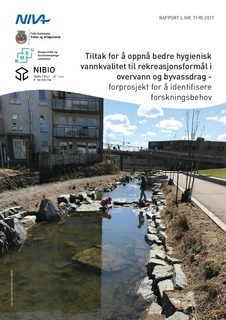| dc.contributor.author | Tryland, Ingun | |
| dc.contributor.author | Mæhlum, Trond | |
| dc.contributor.author | Wennberg, Aina Charlotte | |
| dc.contributor.author | Paruch, Adam | |
| dc.contributor.author | Krystad, Rebekka | |
| dc.contributor.author | Paruch, Lisa | |
| dc.contributor.author | Ranneklev, Sissel Brit | |
| dc.contributor.author | Moe, Therese Fosholt | |
| dc.contributor.author | Haande, Sigrid | |
| dc.contributor.author | Myrmel, Mette | |
| dc.contributor.author | Robertson, Lucy | |
| dc.contributor.author | Fergus, Tharan | |
| dc.contributor.author | Beschorner, Anna-Lena | |
| dc.contributor.author | Kvitsjøen, Julia | |
| dc.contributor.other | Wennberg, Aina Charlotte - Project manager | |
| dc.date.accessioned | 2018-01-30T07:56:03Z | |
| dc.date.available | 2018-01-30T07:56:03Z | |
| dc.date.created | 2018-01-26T09:56:10Z | |
| dc.date.issued | 2017 | |
| dc.identifier | 7190 | |
| dc.identifier.isbn | 978-82-577-6925-3 | |
| dc.identifier.issn | 1894-7948 | |
| dc.identifier.uri | http://hdl.handle.net/11250/2480511 | |
| dc.description.abstract | Rapporten omhandler hygienisk vannkvalitet i Oslos byvassdrag, og beskriver mulig sykdomsrisiko knyttet til eksponering for vannet gjennom rekreasjonsaktiviteter. Forekomst av sykdomsfremkallende virus, bakterier og parasitter fra fekal forurensning vurderes å utgjøre høyest sykdomsrisiko, og det er viktig å ha fokus på tiltak for å minimere tilførslene og nivået av fekal forurensning i urbane vannforekomster der mange mennesker ferdes, samt å unngå at mennesker eksponeres for vannet på dager eller lokaliteter der det er sterkt fekalt forurenset. Rapporten beskriver metoder for å identifisere kilder til fekal forurensning (mikrobiell kildesporing), hurtigmetoder for å overvåke hygienisk vannkvalitet, samt kunnskap om effekt av naturbaserte renseløsninger. Når byvassdrag restaureres refereres det ofte til en rekke økosystemtjenester som tiltaket forventes å oppfylle, der bedre vannkvalitet rangerer høyt, i tillegg til flomdemping, biologisk mangfold, landskapsestetikk mm. I et oppfølgende hovedprosjekt kan det være hensiktsmessig å se på alle aspekter relatert til vannkvalitet og hvordan man best kan lykkes med multifunksjonell restaurering av byvassdrag hvor god vannkvalitet er et viktig delmål. Rapporten identifiserer kunnskapshull og gir forslag til tema som bør utredes mer i forbindelse med restaurering av byvassdrag hvor målet er en forbedret vannkvalitet. | nb_NO |
| dc.description.abstract | This report deal with the hygienic water quality of the rivers in Oslo, and describes the possible health risk related to exposure to this water during recreational activities. The occurrence of infectious virus, bacteria and parasites from fecal sources of pollution is considered to constitute the greatest health related risk. Thus, it is important to focus on measures to reduce the sources and concentrations of fecal pollution to urban water bodies where there are many people, and to include measures to prevent people from being exposed to the water at sites or times when the water has a high level of fecal pollution. The report also describes the methods to identify the sources of fecal pollution (Microbial source tracking), rapid methods to monitor hygienic water quality, and knowledge about the effect of natural treatment systems. There is an anticipation that the restauration of urban rivers will restore many ecosystem services, where better water quality is one of the mostly esteemed, in addition to flood reduction, increased biodiversity, aesthetics and more. It would be appropriate to look at all aspects related to water quality and how to succeed with restauration of a multi-use urban river where good water quality is one of the goals in a follow up project. This report identifies the knowledge gaps and suggests topics for further research in connection to restoration of urban rivers where the purpose is to enhance the water quality. | nb_NO |
| dc.description.sponsorship | Regionale Forskningsfond Hovedstaden og Vann- og avløpsetaten, Oslo kommune | nb_NO |
| dc.language.iso | nob | nb_NO |
| dc.publisher | Norsk institutt for vannforskning | nb_NO |
| dc.relation.ispartof | NIVA-rapport | |
| dc.relation.ispartofseries | NIVA-rapport;7190 | |
| dc.rights | Navngivelse-Ikkekommersiell-DelPåSammeVilkår 4.0 Internasjonal | * |
| dc.rights.uri | http://creativecommons.org/licenses/by-nc-sa/4.0/deed.no | * |
| dc.subject | Hygienisk forurensning | nb_NO |
| dc.subject | Microbial contamination | nb_NO |
| dc.subject | Vannkvalitet | nb_NO |
| dc.subject | Water quality | nb_NO |
| dc.subject | Naturbaserte rensemetoder | nb_NO |
| dc.subject | Natural treatment systems | nb_NO |
| dc.subject | Overflatevann i by | nb_NO |
| dc.subject | Urban water | nb_NO |
| dc.title | Tiltak for å oppnå bedre hygienisk vannkvalitet til rekreasjonsformål i overvann og byvassdrag - forprosjekt for å identifisere forskningsbehov | nb_NO |
| dc.title.alternative | Measures to achieve improved hygienic water quality for recreational activities in storm runoff water and city rivers – pre-project to identify research needs | nb_NO |
| dc.type | Research report | nb_NO |
| dc.description.version | publishedVersion | nb_NO |
| dc.rights.holder | Norsk institutt for vannforskning / Norwegian Institute for Water Research | nb_NO |
| dc.subject.nsi | VDP::Matematikk og naturvitenskap: 400 | nb_NO |
| dc.subject.nsi | VDP::Mathematics and natural scienses: 400 | nb_NO |
| dc.source.pagenumber | 75 | nb_NO |
| dc.source.issue | 7190 | nb_NO |
| dc.identifier.cristin | 1552408 | |
| cristin.unitcode | 7464,20,16,0 | |
| cristin.unitcode | 7464,30,12,0 | |
| cristin.unitcode | 7464,30,19,0 | |
| cristin.unitname | Systemer og teknologi | |
| cristin.unitname | Akvatiske miljøgifter | |
| cristin.unitname | Ferskvannsøkologi | |
| cristin.ispublished | true | |
| cristin.fulltext | original | |


